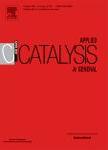版权所有:内蒙古大学图书馆 技术提供:维普资讯• 智图
内蒙古自治区呼和浩特市赛罕区大学西街235号 邮编: 010021

作者机构:College of Material Science and Engineering Taiyuan University of Technology Taiyuan 030024 China State Key Laboratory for Critical Mineral Research and Exploration Institute of Geochemistry Chinese Academy of Sciences Guiyang 550081 China CAS Center for Excellence in Comparative Planetology Hefei 230026 China Guangzhou Key Laboratory of Environmental Catalysis and Pollution Control Guangdong Technology Research Center for Photocatalytic Technology Integration and Equipment Engineering School of Environmental Science and Engineering Guangdong University of Technology Guangzhou 510006 China
出 版 物:《Applied Catalysis A: General》 (Appl Catal A Gen)
年 卷 期:2025年第704卷
学科分类:081704[工学-应用化学] 07[理学] 070304[理学-物理化学(含∶化学物理)] 08[工学] 0817[工学-化学工程与技术] 0703[理学-化学]
基 金:National Natural Science Foundation of China, NSFC, (2020-ZD01, 41902041, 42177192, 2023-ZD01) Fundamental Research Program of Shanxi Province, (202403021211021) Science and Technology Program of Guizhou Province, (1Z039)
主 题:Bisphenol-A Carbon film modified Bi5O7I composite Cr(VI) Simultaneous removal mechanism Visible-light-driven photocatalytic
摘 要:The coexistence of heavy metals and organic pollutants in aquatic ecosystems poses significant threats to environmental and human health. To address this issue, a novel carbon film-modified Bi5O7I photocatalyst (C/Bi5O7I) was developed for the simultaneous removal of bisphenol-A (BPA) and Cr(VI) under visible light. The C/Bi5O7I composite exploited the synergistic effect between the carbon film and Bi5O7I, enhancing light absorption and facilitating efficient electron transfer, which promoted the separation of electron-hole pairs. This mechanism enabled holes to degrade BPA and electrons to reduce Cr(VI), with each process mutually accelerating the other. The composite exhibited high photocatalytic activity across a wide pH range (3.0–11.0) and was minimally inhibited by typical water matrix components. Characterization techniques and theoretical calculations were employed to elucidate the degradation pathways, confirming the stability and efficiency of C/Bi5O7I over multiple cycles. This makes C/Bi5O7I a promising material for treating wastewater contaminated with coexisting heavy metals and organic pollutants. © 2025 Elsevier B.V.